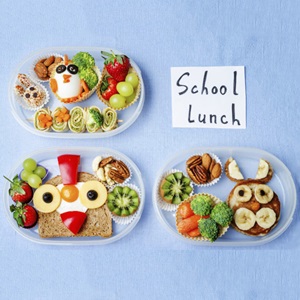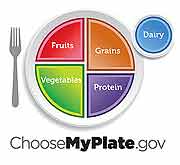What Is the Process for a Student to Withdraw From School at 16 Years of Age
School-Aged Child Nutrition
Helpful feeding information for your school-age child
School-age children (ages 6 to 12) need healthy foods and nutritious snacks. They have a consistent but slow rate of growth and usually eat 4 to 5 times a day (including snacks). Many food habits, likes, and dislikes are set during this time. Family, friends, and the media (especially TV) influence their food choices and eating habits. School-age children are often willing to eat a wider variety of foods than their younger siblings. Eating healthy after-school snacks is important, too, as these snacks may contribute up to one-fourth of the total calorie intake for the day. School-age children have developed more advanced feeding skills and are able to help with meal preparation.
Helpful mealtime hints for school-age children
The following are some helpful mealtime hints:
-
Always serve breakfast, even if it has to be "on the run." Some ideas for a quick, healthy breakfast include:
-
Fruit
-
Milk
-
Bagel
-
Cheese toast
-
Cereal
-
Peanut butter sandwich
-
-
Take advantage of big appetites after school by serving healthy snacks, such as:
-
Fruit
-
Vegetables and dip
-
Yogurt
-
Turkey or chicken sandwich
-
Cheese and crackers
-
Milk and cereal
-
-
Set good examples for eating habits.
-
Allow children to help with meal planning and preparation.
-
Serve meals at the table, instead of in front of the television, to avoid distractions.

7 School Lunch Tips for Picky Eaters
Getting your child to eat healthfully is a struggle for many parents, especially if you have a picky eater in your family. Picky eaters often bring back unopened lunch boxes or ignore the healthy foods you've packed and go straight for the dessert. Learn helpful tips and tricks for outsmarting your picky eater from a Johns Hopkins pediatric dietitian.

Healthy food choices
The MyPlate icon is a guideline to help you and your child eat a healthy diet. MyPlate can help you and your child eat a variety of foods while encouraging the right amount of calories and fat.
The USDA and the U.S. Department of Health and Human Services have prepared the plate to guide parents in selecting foods for children age 2 and older.
The MyPlate icon is divided into 5 food group categories, emphasizing the nutritional intake of the following:
-
Grains.Foods that are made from wheat, rice, oats, cornmeal, barley, or another cereal grain are grain products. Examples include whole wheat, brown rice, and oatmeal.
-
Vegetables. Vary your vegetables. Choose a variety of colorful vegetables, including dark green, red, and orange vegetables, legumes (peas and beans), and starchy vegetables.
-
Fruits. Any fruit or 100% fruit juice counts as part of the fruit group. Fruits may be fresh, canned, frozen, or dried, and may be whole, cut up, or pureed.
-
Dairy. Milk products and many foods made from milk are considered part of this food group. Focus on fat-free or low-fat products, as well as those that are high in calcium.
-
Protein. Go lean on protein. Choose low-fat or lean meats and poultry. Vary your protein routine. Choose more fish, nuts, seeds, peas, and beans.
Oils are not a food group, yet some, like nut oils, contain essential nutrients and can be included in the diet. Animal fats are solid fats and should be avoided.
Exercise and everyday physical activity should also be included with a healthy dietary plan.
Nutrition and activity tips
Here are tips to follow:
-
Try to control when and where food is eaten by your children by providing regular daily meal times with social interaction and demonstration of healthy eating behaviors.
-
Involve children in the selection and preparation of foods. Teach them to make healthy choices by providing opportunities to select foods based on their nutritional value.
-
For children in general, reported dietary intakes of the following are low enough to be of concern by the USDA: calcium, magnesium, potassium, and fiber. Select foods with these nutrients when possible.
-
Most Americans need to reduce the number of calories they consume. When it comes to weight control, calories do count. Controlling portion sizes and eating nonprocessed foods helps limit calorie intake and increase nutrients.
-
Parents are encouraged to make recommended serving sizes for children.
-
Parents are encouraged to limit children's video, television watching, and computer use to less than 2 hours daily and replace the sitting activities with activities that require more movement.
-
Children and adolescents need at least 60 minutes of moderate to vigorous physical activity on most days to have good health and fitness and for healthy weight during growth.
-
To prevent dehydration, encourage children to drink fluid regularly during physical activity and to drink several glasses of water or other fluid after the physical activity is completed.
To find more information about the Dietary Guidelines for Americans 2015–2020 and to determine the appropriate dietary recommendations for your child's age, sex, and physical activity level, visit the Online Resources page for the links to the ChooseMyPlate.gov and 2015–2020 Dietary Guidelines sites. Please note that the MyPlate plan is designed for people older than age 2 who do not have chronic health conditions.
Always talk with your child's health care provider regarding his or her healthy diet and exercise needs.
What Is the Process for a Student to Withdraw From School at 16 Years of Age
Source: https://www.hopkinsmedicine.org/health/wellness-and-prevention/schoolaged-child-nutrition
0 Response to "What Is the Process for a Student to Withdraw From School at 16 Years of Age"
Postar um comentário